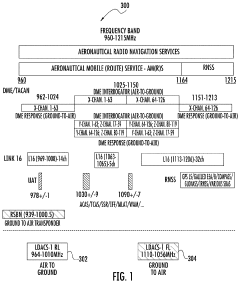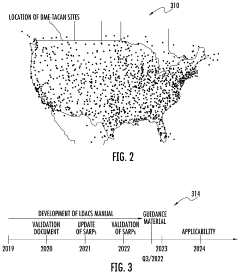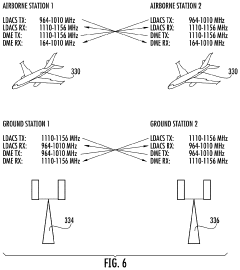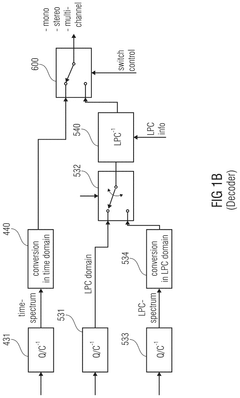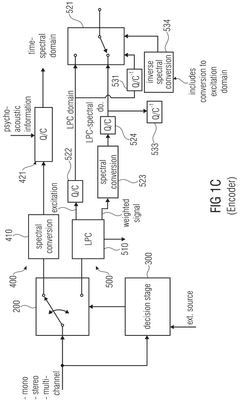How LDAC Facilitates High-Quality Audio Distribution?
JUL 4, 20259 MIN READ
Generate Your Research Report Instantly with AI Agent
Patsnap Eureka helps you evaluate technical feasibility & market potential.
LDAC Technology Overview and Objectives
LDAC (Low Latency Audio Codec) is a cutting-edge audio coding technology developed by Sony Corporation to address the growing demand for high-quality wireless audio transmission. This innovative codec represents a significant leap forward in the realm of Bluetooth audio, aiming to overcome the limitations of previous compression methods and deliver an unprecedented level of audio fidelity in wireless devices.
The primary objective of LDAC is to facilitate the distribution of high-resolution audio content over Bluetooth connections without compromising sound quality. By employing advanced encoding techniques, LDAC can transmit audio data at up to 990 kbps, which is substantially higher than conventional Bluetooth codecs. This increased bandwidth allows for the preservation of more audio information, resulting in a listening experience that closely resembles wired high-fidelity systems.
LDAC's development is rooted in the growing consumer demand for superior audio quality in portable devices. As the popularity of high-resolution audio formats has surged, there has been a parallel need for wireless transmission methods that can faithfully reproduce these high-quality audio sources. LDAC aims to bridge this gap, enabling users to enjoy studio-quality sound on their wireless headphones, speakers, and other Bluetooth-enabled devices.
The technology behind LDAC represents a convergence of several key advancements in audio processing and data compression. It utilizes adaptive bit rate allocation, which dynamically adjusts the transmission rate based on the wireless environment and audio content. This ensures optimal performance across various usage scenarios, from quiet indoor settings to noisy outdoor environments.
Furthermore, LDAC incorporates sophisticated error detection and correction mechanisms to maintain audio integrity even in challenging wireless conditions. These features work in tandem to minimize latency and dropouts, addressing common issues associated with Bluetooth audio transmission.
As the audio industry continues to evolve, LDAC positions itself as a forward-looking solution that anticipates future trends in high-fidelity audio consumption. Its ability to support 24-bit/96kHz audio transmission aligns with the increasing availability of high-resolution music streaming services and the growing audiophile market segment.
By setting new standards for wireless audio quality, LDAC aims to revolutionize the way consumers experience music and other audio content on their portable devices. Its adoption by major smartphone manufacturers and audio equipment producers underscores its potential to become a dominant force in the high-end wireless audio market.
The primary objective of LDAC is to facilitate the distribution of high-resolution audio content over Bluetooth connections without compromising sound quality. By employing advanced encoding techniques, LDAC can transmit audio data at up to 990 kbps, which is substantially higher than conventional Bluetooth codecs. This increased bandwidth allows for the preservation of more audio information, resulting in a listening experience that closely resembles wired high-fidelity systems.
LDAC's development is rooted in the growing consumer demand for superior audio quality in portable devices. As the popularity of high-resolution audio formats has surged, there has been a parallel need for wireless transmission methods that can faithfully reproduce these high-quality audio sources. LDAC aims to bridge this gap, enabling users to enjoy studio-quality sound on their wireless headphones, speakers, and other Bluetooth-enabled devices.
The technology behind LDAC represents a convergence of several key advancements in audio processing and data compression. It utilizes adaptive bit rate allocation, which dynamically adjusts the transmission rate based on the wireless environment and audio content. This ensures optimal performance across various usage scenarios, from quiet indoor settings to noisy outdoor environments.
Furthermore, LDAC incorporates sophisticated error detection and correction mechanisms to maintain audio integrity even in challenging wireless conditions. These features work in tandem to minimize latency and dropouts, addressing common issues associated with Bluetooth audio transmission.
As the audio industry continues to evolve, LDAC positions itself as a forward-looking solution that anticipates future trends in high-fidelity audio consumption. Its ability to support 24-bit/96kHz audio transmission aligns with the increasing availability of high-resolution music streaming services and the growing audiophile market segment.
By setting new standards for wireless audio quality, LDAC aims to revolutionize the way consumers experience music and other audio content on their portable devices. Its adoption by major smartphone manufacturers and audio equipment producers underscores its potential to become a dominant force in the high-end wireless audio market.
Market Demand for High-Quality Wireless Audio
The demand for high-quality wireless audio has been steadily increasing in recent years, driven by several key factors. Consumers are increasingly seeking immersive audio experiences across various devices and platforms, from smartphones and tablets to smart home speakers and automotive systems. This trend has been further accelerated by the growing popularity of streaming services, which offer high-resolution audio content to subscribers.
The market for wireless audio devices has seen significant growth, with a particular emphasis on premium products that deliver superior sound quality. This shift is evident in the rising sales of high-end wireless headphones, earbuds, and speakers from both established audio brands and tech giants entering the audio space. Consumers are showing a willingness to invest in devices that can reproduce audio with greater fidelity, mirroring the quality of wired solutions.
One of the primary drivers of this demand is the increasing adoption of lossless and high-resolution audio formats by streaming platforms. Services like Tidal, Amazon Music HD, and Apple Music have introduced lossless audio tiers, pushing the boundaries of what's possible in wireless audio transmission. This has created a need for advanced codec technologies that can efficiently transmit high-bitrate audio over Bluetooth connections.
The mobile market, in particular, has been a significant contributor to the demand for high-quality wireless audio. As smartphones continue to evolve as primary entertainment devices, users are seeking audio solutions that can match the high-resolution displays and powerful processors of modern devices. This has led to a surge in demand for wireless earbuds and headphones that can deliver studio-quality sound without the constraints of wires.
In the automotive sector, there's a growing emphasis on premium audio experiences, with car manufacturers partnering with renowned audio brands to develop sophisticated in-car sound systems. These systems often incorporate wireless connectivity, necessitating high-quality audio transmission technologies to maintain the integrity of the sound from source to speaker.
The professional audio market has also contributed to the demand for high-quality wireless audio solutions. Recording studios, live performance venues, and broadcast environments are increasingly adopting wireless systems that can maintain the highest levels of audio fidelity. This has pushed the development of advanced wireless audio technologies that can meet the exacting standards of audio professionals.
As the Internet of Things (IoT) ecosystem expands, there's an increasing need for seamless audio integration across various smart devices. This interconnected environment demands wireless audio solutions that can deliver high-quality sound while maintaining low latency and energy efficiency, further driving innovation in wireless audio transmission technologies.
The market for wireless audio devices has seen significant growth, with a particular emphasis on premium products that deliver superior sound quality. This shift is evident in the rising sales of high-end wireless headphones, earbuds, and speakers from both established audio brands and tech giants entering the audio space. Consumers are showing a willingness to invest in devices that can reproduce audio with greater fidelity, mirroring the quality of wired solutions.
One of the primary drivers of this demand is the increasing adoption of lossless and high-resolution audio formats by streaming platforms. Services like Tidal, Amazon Music HD, and Apple Music have introduced lossless audio tiers, pushing the boundaries of what's possible in wireless audio transmission. This has created a need for advanced codec technologies that can efficiently transmit high-bitrate audio over Bluetooth connections.
The mobile market, in particular, has been a significant contributor to the demand for high-quality wireless audio. As smartphones continue to evolve as primary entertainment devices, users are seeking audio solutions that can match the high-resolution displays and powerful processors of modern devices. This has led to a surge in demand for wireless earbuds and headphones that can deliver studio-quality sound without the constraints of wires.
In the automotive sector, there's a growing emphasis on premium audio experiences, with car manufacturers partnering with renowned audio brands to develop sophisticated in-car sound systems. These systems often incorporate wireless connectivity, necessitating high-quality audio transmission technologies to maintain the integrity of the sound from source to speaker.
The professional audio market has also contributed to the demand for high-quality wireless audio solutions. Recording studios, live performance venues, and broadcast environments are increasingly adopting wireless systems that can maintain the highest levels of audio fidelity. This has pushed the development of advanced wireless audio technologies that can meet the exacting standards of audio professionals.
As the Internet of Things (IoT) ecosystem expands, there's an increasing need for seamless audio integration across various smart devices. This interconnected environment demands wireless audio solutions that can deliver high-quality sound while maintaining low latency and energy efficiency, further driving innovation in wireless audio transmission technologies.
Current State and Challenges in Bluetooth Audio Codecs
Bluetooth audio codecs have undergone significant evolution since their inception, with the current landscape dominated by several key players. The most widely adopted codec remains SBC (Sub-Band Coding), which is mandatory for all Bluetooth audio devices. However, SBC's limitations in audio quality have led to the development of more advanced codecs.
aptX, developed by Qualcomm, has gained popularity for its improved audio quality and lower latency compared to SBC. It comes in several variants, including aptX HD for high-resolution audio and aptX Adaptive for dynamic bitrate adjustment. AAC (Advanced Audio Coding) is another prominent codec, particularly favored by Apple devices for its efficiency and quality.
Despite these advancements, Bluetooth audio codecs face several challenges. The primary issue is the bandwidth limitation of Bluetooth technology itself. Even with the latest Bluetooth 5.0 standard, the maximum theoretical bandwidth is insufficient for uncompressed high-resolution audio transmission.
Latency remains a significant concern, especially for applications requiring precise audio-video synchronization, such as gaming and video playback. While codecs like aptX Low Latency have made improvements, achieving imperceptible latency levels remains challenging within Bluetooth's constraints.
Power consumption is another critical factor, particularly for portable devices. More complex codecs often require more processing power, leading to increased battery drain. Balancing audio quality with energy efficiency is an ongoing challenge for codec developers.
Compatibility issues also persist in the Bluetooth audio ecosystem. Not all devices support the same codecs, leading to situations where the audio quality is limited by the least capable device in the chain. This fragmentation can result in a suboptimal user experience and confusion for consumers.
The push for higher resolution audio has led to the development of codecs like LDAC by Sony and Samsung's Scalable Codec. These aim to transmit audio at higher bitrates, but their effectiveness is still limited by Bluetooth's inherent bandwidth constraints.
As the demand for wireless audio quality continues to grow, particularly with the rise of high-resolution streaming services, Bluetooth audio codecs are under pressure to evolve further. The industry is exploring new approaches, including leveraging upcoming Bluetooth standards and potentially integrating with other wireless technologies to overcome current limitations.
aptX, developed by Qualcomm, has gained popularity for its improved audio quality and lower latency compared to SBC. It comes in several variants, including aptX HD for high-resolution audio and aptX Adaptive for dynamic bitrate adjustment. AAC (Advanced Audio Coding) is another prominent codec, particularly favored by Apple devices for its efficiency and quality.
Despite these advancements, Bluetooth audio codecs face several challenges. The primary issue is the bandwidth limitation of Bluetooth technology itself. Even with the latest Bluetooth 5.0 standard, the maximum theoretical bandwidth is insufficient for uncompressed high-resolution audio transmission.
Latency remains a significant concern, especially for applications requiring precise audio-video synchronization, such as gaming and video playback. While codecs like aptX Low Latency have made improvements, achieving imperceptible latency levels remains challenging within Bluetooth's constraints.
Power consumption is another critical factor, particularly for portable devices. More complex codecs often require more processing power, leading to increased battery drain. Balancing audio quality with energy efficiency is an ongoing challenge for codec developers.
Compatibility issues also persist in the Bluetooth audio ecosystem. Not all devices support the same codecs, leading to situations where the audio quality is limited by the least capable device in the chain. This fragmentation can result in a suboptimal user experience and confusion for consumers.
The push for higher resolution audio has led to the development of codecs like LDAC by Sony and Samsung's Scalable Codec. These aim to transmit audio at higher bitrates, but their effectiveness is still limited by Bluetooth's inherent bandwidth constraints.
As the demand for wireless audio quality continues to grow, particularly with the rise of high-resolution streaming services, Bluetooth audio codecs are under pressure to evolve further. The industry is exploring new approaches, including leveraging upcoming Bluetooth standards and potentially integrating with other wireless technologies to overcome current limitations.
LDAC Technical Implementation and Features
01 LDAC codec implementation for high-quality audio transmission
LDAC is a high-resolution audio codec developed for Bluetooth audio transmission. It enables the transfer of high-quality audio data at higher bit rates compared to standard codecs. The implementation of LDAC in audio devices can significantly improve the overall audio quality, providing a near lossless listening experience.- LDAC codec implementation for high-quality audio transmission: LDAC is a high-resolution audio codec developed for Bluetooth audio transmission. It enables the transfer of high-quality audio data over Bluetooth connections, offering improved sound quality compared to standard codecs. LDAC supports various bit rates and can adapt to different network conditions to maintain optimal audio performance.
- Audio quality enhancement through signal processing: Various signal processing techniques are employed to enhance audio quality in LDAC systems. These may include noise reduction, dynamic range compression, and frequency response optimization. Advanced algorithms are used to analyze and adjust audio signals in real-time, resulting in clearer and more detailed sound reproduction.
- Adaptive bit rate and sampling frequency adjustment: LDAC systems can dynamically adjust bit rates and sampling frequencies based on network conditions and device capabilities. This adaptive approach ensures optimal audio quality while maintaining stable connections. The system can switch between different quality modes to balance audio fidelity and connection stability.
- Integration with audio playback devices and systems: LDAC technology is integrated into various audio playback devices and systems, including smartphones, headphones, and home audio equipment. This integration allows for seamless high-quality audio streaming across different platforms and devices, enhancing the overall user experience in audio consumption.
- Compatibility and interoperability with other audio technologies: LDAC is designed to be compatible and interoperable with other audio technologies and standards. This ensures that LDAC-enabled devices can work effectively with a wide range of audio equipment and systems, providing users with flexibility and high-quality audio across different setups and configurations.
02 Audio signal processing and enhancement techniques
Various signal processing techniques are employed to enhance audio quality in LDAC-enabled devices. These may include noise reduction, dynamic range compression, and frequency response optimization. Advanced algorithms are used to analyze and adjust audio signals in real-time, resulting in clearer and more balanced sound output.Expand Specific Solutions03 Integration of LDAC with other audio technologies
LDAC can be integrated with other audio technologies to further improve sound quality. This may include combining LDAC with digital signal processors, advanced equalizers, or spatial audio technologies. The synergy between these technologies can result in a more immersive and high-fidelity audio experience.Expand Specific Solutions04 Adaptive bit rate and connection stability for LDAC
LDAC incorporates adaptive bit rate technology to maintain optimal audio quality under varying wireless conditions. The codec can dynamically adjust its bit rate to ensure a stable connection and minimize dropouts, while still delivering the highest possible audio quality based on the current transmission conditions.Expand Specific Solutions05 Device compatibility and optimization for LDAC
To fully utilize LDAC's capabilities, both transmitting and receiving devices need to be optimized for the codec. This includes hardware considerations such as DAC quality, amplifier design, and overall audio circuitry. Software optimizations and firmware updates can also play a crucial role in maximizing LDAC audio quality across different devices.Expand Specific Solutions
Key Players in LDAC and Wireless Audio Industry
The LDAC (Low Latency Audio Codec) technology landscape is characterized by a competitive market in the advanced audio distribution sector. The industry is in a growth phase, with increasing demand for high-quality wireless audio solutions. The market size is expanding as more consumers adopt premium audio products. Technologically, LDAC is relatively mature, with key players like Sony (developer of LDAC), Samsung Electronics, and Qualcomm driving innovation. Other significant contributors include Fraunhofer-Gesellschaft, Analog Devices, and Dolby Laboratories, who are actively developing complementary audio technologies. The involvement of major smartphone manufacturers and audio equipment companies indicates LDAC's growing importance in the consumer electronics ecosystem.
Samsung Electronics Co., Ltd.
Technical Solution: Samsung has embraced LDAC technology in many of its devices, particularly in its Galaxy line of smartphones and tablets. By incorporating LDAC, Samsung enables its devices to transmit high-resolution audio wirelessly at up to 990 kbps[5]. This implementation allows for near CD-quality audio streaming over Bluetooth. Samsung has also developed its own audio technologies, such as Adaptive Sound, which analyzes the content being played and the environment to optimize audio output[6]. The combination of LDAC support and proprietary technologies demonstrates Samsung's commitment to delivering high-quality audio experiences across various use cases.
Strengths: Wide adoption of LDAC in popular devices, complementary audio technologies. Weaknesses: Dependent on Sony's LDAC technology, potential licensing costs.
QUALCOMM, Inc.
Technical Solution: Qualcomm, while not directly involved with LDAC, has developed its own high-quality audio codec called aptX, which competes with LDAC in the market for high-fidelity Bluetooth audio. The latest version, aptX Adaptive, supports bit rates up to 420 kbps and dynamically adjusts based on the audio content and RF environment[7]. Qualcomm's approach focuses on low latency and scalable bit rate, making it suitable for various applications from music streaming to gaming. Their technology is widely adopted in many Android devices and Bluetooth audio products, offering an alternative to LDAC for high-quality audio distribution[8].
Strengths: Widespread adoption in Android ecosystem, focus on low latency. Weaknesses: Lower maximum bit rate compared to LDAC, potential compatibility issues with LDAC-only devices.
Core Innovations in LDAC Audio Codec
Enhanced ldacs that uses doppler shifts in carrier signals for positioning and navigation
PatentPendingUS20220317290A1
Innovation
- The enhanced LDACS system employs a network architecture that includes multiple LDACS ground stations transmitting carrier signals with offset frequencies, allowing airborne stations to determine position information using Doppler shifts, and uses this information for navigation and communication, while also implementing channel aggregation and dynamic resource allocation to optimize spectrum use and interference management.
Low bitrate audio encoding/decoding scheme having cascaded switches
PatentActiveUS20250061902A1
Innovation
- An audio encoder that employs two distinct coding branches, one using a frequency-domain algorithm and the other using a Linear Predictive Coding (LPC) algorithm, with switches to dynamically select between them based on the audio signal characteristics, allowing for conversion between different domains to optimize encoding.
Compatibility and Integration with Audio Devices
LDAC's compatibility and integration with audio devices is a crucial factor in its widespread adoption and effectiveness in facilitating high-quality audio distribution. This codec technology, developed by Sony, has been designed to work seamlessly with a wide range of audio devices, ensuring that users can enjoy high-resolution audio across various platforms and systems.
One of the key aspects of LDAC's compatibility is its integration with Android devices. Since Android 8.0 (Oreo), LDAC has been natively supported by the Android operating system. This integration allows Android smartphones and tablets to transmit high-quality audio to compatible Bluetooth devices without the need for additional software or hardware modifications. This native support has significantly expanded the reach of LDAC technology, making it accessible to millions of Android users worldwide.
In addition to Android devices, LDAC is also compatible with a growing number of audio equipment manufacturers. Many leading brands in the audio industry have incorporated LDAC support into their products, including wireless headphones, speakers, and home audio systems. This broad compatibility ensures that consumers have a wide range of options when choosing LDAC-enabled devices, promoting the technology's adoption and usage.
LDAC's integration extends beyond consumer electronics to professional audio equipment as well. Some high-end digital audio players, professional-grade headphones, and studio monitoring systems now support LDAC, allowing audio professionals to benefit from its high-quality audio transmission capabilities in their work environments.
The codec's flexibility in terms of transmission rates is another factor that enhances its compatibility. LDAC can operate at different bit rates (330 kbps, 660 kbps, or 990 kbps), allowing it to adapt to various Bluetooth connection qualities and device capabilities. This adaptability ensures that LDAC can provide the best possible audio quality across a wide range of scenarios and device combinations.
Furthermore, LDAC's integration with other audio technologies has been a focus area for its developers. For instance, efforts have been made to ensure LDAC works well with various Digital Signal Processing (DSP) technologies and audio enhancement features commonly found in modern audio devices. This integration allows users to benefit from LDAC's high-quality audio transmission while still enjoying other audio processing features they may prefer.
As the audio industry continues to evolve, LDAC's developers are working on expanding its compatibility and integration capabilities. This includes potential integration with emerging audio technologies and standards, as well as continued efforts to optimize its performance across an even wider range of devices and use cases.
One of the key aspects of LDAC's compatibility is its integration with Android devices. Since Android 8.0 (Oreo), LDAC has been natively supported by the Android operating system. This integration allows Android smartphones and tablets to transmit high-quality audio to compatible Bluetooth devices without the need for additional software or hardware modifications. This native support has significantly expanded the reach of LDAC technology, making it accessible to millions of Android users worldwide.
In addition to Android devices, LDAC is also compatible with a growing number of audio equipment manufacturers. Many leading brands in the audio industry have incorporated LDAC support into their products, including wireless headphones, speakers, and home audio systems. This broad compatibility ensures that consumers have a wide range of options when choosing LDAC-enabled devices, promoting the technology's adoption and usage.
LDAC's integration extends beyond consumer electronics to professional audio equipment as well. Some high-end digital audio players, professional-grade headphones, and studio monitoring systems now support LDAC, allowing audio professionals to benefit from its high-quality audio transmission capabilities in their work environments.
The codec's flexibility in terms of transmission rates is another factor that enhances its compatibility. LDAC can operate at different bit rates (330 kbps, 660 kbps, or 990 kbps), allowing it to adapt to various Bluetooth connection qualities and device capabilities. This adaptability ensures that LDAC can provide the best possible audio quality across a wide range of scenarios and device combinations.
Furthermore, LDAC's integration with other audio technologies has been a focus area for its developers. For instance, efforts have been made to ensure LDAC works well with various Digital Signal Processing (DSP) technologies and audio enhancement features commonly found in modern audio devices. This integration allows users to benefit from LDAC's high-quality audio transmission while still enjoying other audio processing features they may prefer.
As the audio industry continues to evolve, LDAC's developers are working on expanding its compatibility and integration capabilities. This includes potential integration with emerging audio technologies and standards, as well as continued efforts to optimize its performance across an even wider range of devices and use cases.
Energy Efficiency in High-Quality Audio Transmission
Energy efficiency is a critical consideration in high-quality audio transmission, particularly when utilizing advanced codecs like LDAC. The LDAC codec, developed by Sony, aims to deliver high-resolution audio wirelessly while maintaining optimal energy consumption. This balance is crucial for portable devices and battery-powered audio equipment.
LDAC employs sophisticated compression algorithms that allow for efficient data transmission without compromising audio quality. By utilizing adaptive bit rate technology, LDAC can adjust its transmission rate based on the available bandwidth and signal strength. This dynamic approach ensures that energy is not wasted on unnecessarily high bit rates when network conditions are less than ideal.
The codec's ability to transmit at up to 990 kbps enables it to deliver near-lossless audio quality, which is significantly higher than standard Bluetooth codecs. However, this high-quality transmission could potentially lead to increased power consumption. To mitigate this, LDAC incorporates power-saving features that optimize energy usage during playback and transmission.
One of the key energy-efficient aspects of LDAC is its intelligent processing capabilities. The codec utilizes advanced DSP (Digital Signal Processing) techniques to minimize computational overhead, thereby reducing the energy required for encoding and decoding audio streams. This efficiency is particularly beneficial for mobile devices, where battery life is a paramount concern.
LDAC also supports multiple operation modes, allowing devices to switch between different quality levels based on their current power status. This flexibility enables users to prioritize either audio quality or battery life, depending on their specific needs and usage scenarios.
Furthermore, LDAC's integration with Bluetooth Low Energy (BLE) technology contributes to its overall energy efficiency. BLE allows for reduced power consumption during device discovery and connection establishment phases, which are often overlooked but can significantly impact battery life over time.
The codec's energy efficiency extends to its implementation in hardware as well. Many modern audio chips and SoCs (System on Chips) are designed with LDAC support in mind, optimizing power consumption at the hardware level. This integration ensures that devices can handle LDAC encoding and decoding with minimal additional energy overhead.
As the demand for high-quality wireless audio continues to grow, the importance of energy-efficient transmission methods like LDAC becomes increasingly apparent. The codec's ability to balance superior audio quality with responsible power management positions it as a key technology in the evolving landscape of wireless audio distribution.
LDAC employs sophisticated compression algorithms that allow for efficient data transmission without compromising audio quality. By utilizing adaptive bit rate technology, LDAC can adjust its transmission rate based on the available bandwidth and signal strength. This dynamic approach ensures that energy is not wasted on unnecessarily high bit rates when network conditions are less than ideal.
The codec's ability to transmit at up to 990 kbps enables it to deliver near-lossless audio quality, which is significantly higher than standard Bluetooth codecs. However, this high-quality transmission could potentially lead to increased power consumption. To mitigate this, LDAC incorporates power-saving features that optimize energy usage during playback and transmission.
One of the key energy-efficient aspects of LDAC is its intelligent processing capabilities. The codec utilizes advanced DSP (Digital Signal Processing) techniques to minimize computational overhead, thereby reducing the energy required for encoding and decoding audio streams. This efficiency is particularly beneficial for mobile devices, where battery life is a paramount concern.
LDAC also supports multiple operation modes, allowing devices to switch between different quality levels based on their current power status. This flexibility enables users to prioritize either audio quality or battery life, depending on their specific needs and usage scenarios.
Furthermore, LDAC's integration with Bluetooth Low Energy (BLE) technology contributes to its overall energy efficiency. BLE allows for reduced power consumption during device discovery and connection establishment phases, which are often overlooked but can significantly impact battery life over time.
The codec's energy efficiency extends to its implementation in hardware as well. Many modern audio chips and SoCs (System on Chips) are designed with LDAC support in mind, optimizing power consumption at the hardware level. This integration ensures that devices can handle LDAC encoding and decoding with minimal additional energy overhead.
As the demand for high-quality wireless audio continues to grow, the importance of energy-efficient transmission methods like LDAC becomes increasingly apparent. The codec's ability to balance superior audio quality with responsible power management positions it as a key technology in the evolving landscape of wireless audio distribution.
Unlock deeper insights with Patsnap Eureka Quick Research — get a full tech report to explore trends and direct your research. Try now!
Generate Your Research Report Instantly with AI Agent
Supercharge your innovation with Patsnap Eureka AI Agent Platform!
